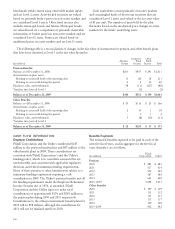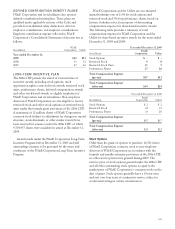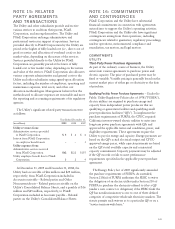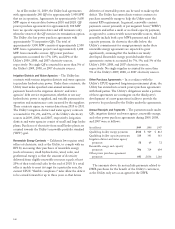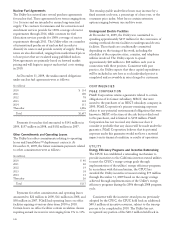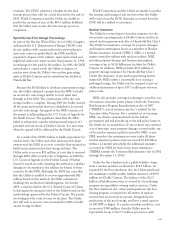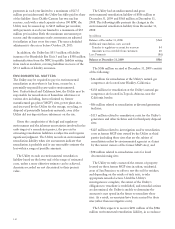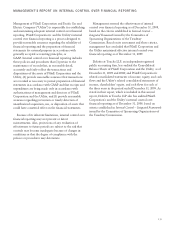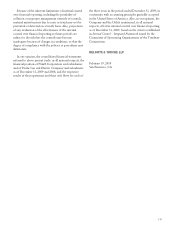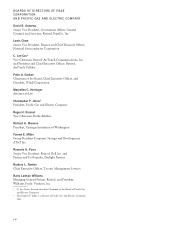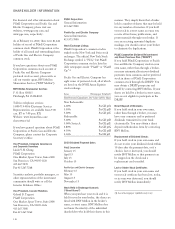PG&E 2009 Annual Report Download - page 113
Download and view the complete annual report
Please find page 113 of the 2009 PG&E annual report below. You can navigate through the pages in the report by either clicking on the pages listed below, or by using the keyword search tool below to find specific information within the annual report.revenues. The CPUC adopted a schedule for the final
true-up process that calls for a final decision by the end of
2010. PG&E Corporation and the Utility are unable to
predict the amount, if any, of the $40.3 million holdback
that the Utility may receive after the true-up process is
completed.
Spent Nuclear Fuel Storage Proceedings
As part of the Nuclear Waste Policy Act of 1982, Congress
authorized the U.S. Department of Energy (“DOE”) and
electric utilities with commercial nuclear power plants to
enter into contracts under which the DOE would be
required to dispose of the utilities’ spent nuclear fuel and
high-level radioactive waste no later than January 31, 1998,
in exchange for fees paid by the utilities. In 1983, the DOE
entered into a contract with the Utility to dispose of
nuclear waste from the Utility’s two nuclear generating
units at Diablo Canyon and its retired nuclear facility at
Humboldt Bay.
Because the DOE failed to develop a permanent storage
site, the Utility obtained a permit from the NRC to build
an on-site dry cask storage facility to store spent fuel
through at least 2024. The construction of the dry cask
storage facility is complete. During 2009 the Utility moved
all the spent nuclear fuel that was scheduled to be moved
into dry cask storage. An appeal of the NRC’s issuance of
the permit is still pending in the U.S. Court of Appeals for
the Ninth Circuit. The appellants claim that the NRC
failed to adequately consider environmental impacts of a
potential terrorist attack at Diablo Canyon. It is uncertain
when the appeal will be addressed by the Ninth Circuit.
As a result of the DOE’s failure to build a repository for
nuclear waste, the Utility and other nuclear power plant
owners sued the DOE to recover costs that they incurred to
build on-site spent nuclear fuel storage facilities. The
Utility seeks to recover $92 million of costs that it incurred
through 2004. After several years of litigation, in 2008 the
U.S. Court of Appeals for the Federal Circuit (“Federal
Circuit”) issued an order clarifying the method to calculate
damages to be awarded to the utilities for breach of their
contracts by the DOE. Although the DOE has conceded
that the Utility is entitled to recover approximately $82
million based on this method, the DOE continues to
challenge the method in related litigation. In October
2009, a trial was held in the U.S. Federal Court of Claims
to determine the amounts owed to the Utility based on the
methodology approved by the Federal Circuit. The parties
are waiting for the court to issue its decision. The Utility
also will seek to recover costs incurred after 2004 to build
on-site storage facilities.
PG&E Corporation and the Utility are unable to predict
the amount and timing of any recoveries that the Utility
will receive from the DOE. Amounts recovered from the
DOE will be credited to customers.
Nuclear Insurance
The Utility has several types of nuclear insurance for the
two nuclear operating units at Diablo Canyon and for its
retired nuclear generation facility at Humboldt Bay Unit 3.
The Utility has insurance coverage for property damages
and business interruption losses as a member of Nuclear
Electric Insurance Limited (“NEIL”). NEIL is a mutual
insurer owned by utilities with nuclear facilities. NEIL
provides property damage and business interruption
coverage of up to $3.24 billion per incident for Diablo
Canyon. In addition, NEIL provides $131 million of
property damage insurance for Humboldt Bay Unit 3.
Under this insurance, if any nuclear generating facility
insured by NEIL suffers a catastrophic loss causing a
prolonged outage, the Utility may be required to pay an
additional premium of up to $39.7 million per one-year
policy term.
NEIL also provides coverage for damages caused by acts
of terrorism at nuclear power plants. Under the Terrorism
Risk Insurance Program Reauthorization Act of 2007
(“TRIPRA”), acts of terrorism may be “certified” by the
Secretary of the Treasury. For a certified act of terrorism,
NEIL can obtain compensation from the federal
government and will provide up to the full policy limits to
the Utility for an insured loss. If one or more non-certified
acts of terrorism cause property damage covered under any
of the nuclear insurance policies issued by NEIL to any
NEIL member, the maximum recovery under all those
nuclear insurance policies may not exceed $3.24 billion
within a 12-month period plus the additional amounts
recovered by NEIL for these losses from reinsurance.
(TRIPRA extends the Terrorism Risk Insurance Act of 2002
through December 31, 2014.)
Under the Price-Anderson Act, public liability claims
from a nuclear incident are limited to $12.5 billion. As
required by the Price-Anderson Act, the Utility purchased
the maximum available public liability insurance of $300
million for Diablo Canyon. The balance of the $12.5
billion of liability protection is covered by a loss-sharing
program among utilities owning nuclear reactors. Under
the Price-Anderson Act, owner participation in this loss-
sharing program is required for all owners of nuclear
reactors that are licensed to operate, designed for the
production of electrical energy, and have a rated capacity
of 100 MW or higher. If a nuclear incident results in costs
in excess of $300 million, then the Utility may be
responsible for up to $117.5 million per reactor, with
109



